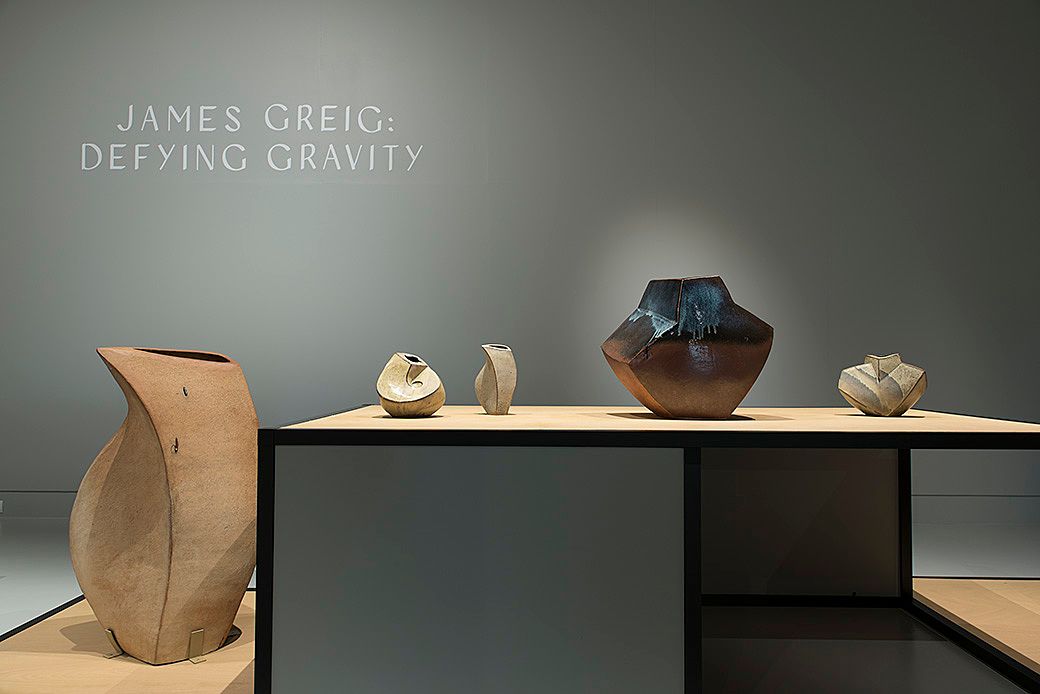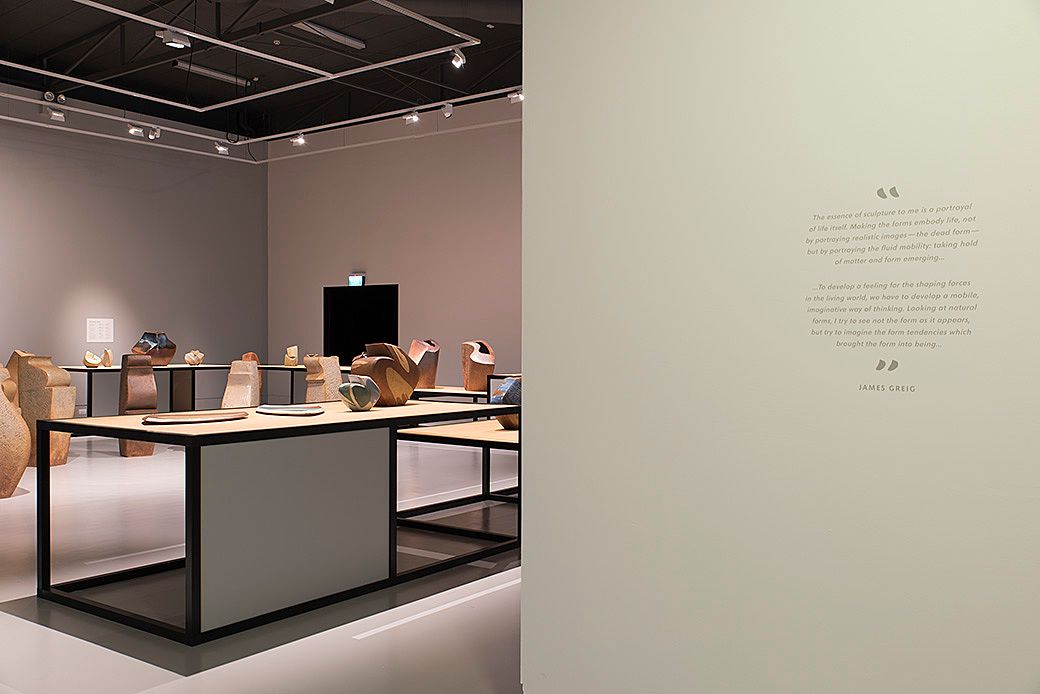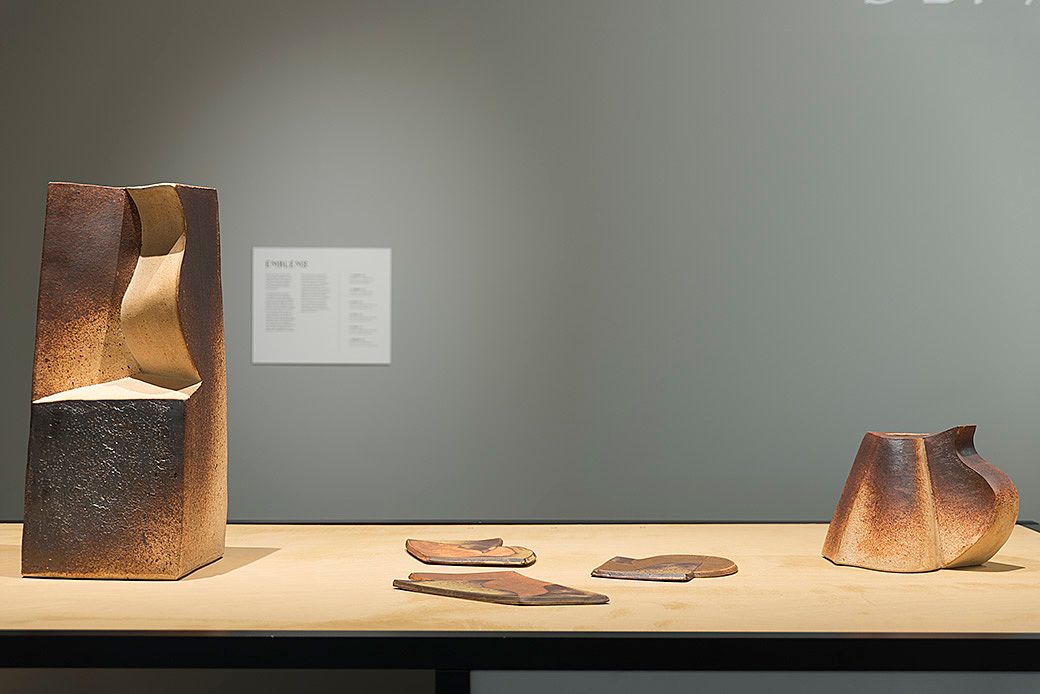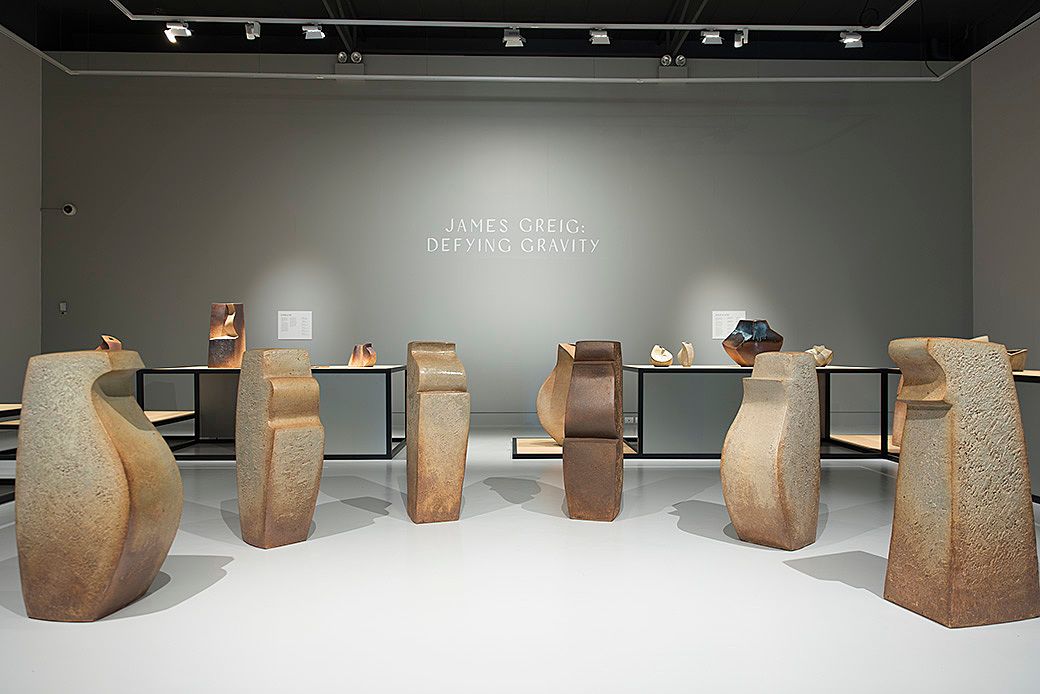A feeling for form: James Greig at The Dowse
Ioana Gordon-Smith considers little-known histories in The Dowse’s current exhibition 'Defying Gravity', which aims to introduce a new audience to the work of the late potter James Greig.
Ioana Gordon-Smith considers little-known histories in The Dowse’s current exhibition Defying Gravity, which aims to introduce a new audience to the work of the late potter James Greig.
Over the past few months, images of stunning ceramics have been littering my Instagram feed. An angular vase made of two rhombus forms joined only along two sides, each section jutting out in a different direction. A sculptural work that would have reached my shoulder. A pot with a round lip and base but a square belly.
The images were posted by Sian van Dyk, a curator at The Dowse Art Museum (which often re-grammed the images). Van Dyk had been working on a major exhibition at The Dowse dedicated to the late ceramicist James Greig. Defying Gravity is one of the few exhibitions of Greig’s works since his early death at the age of 50 in 1986.[i] (Tragically, Greig passed away the same day a solo exhibition of over 200 works opened in Kyoto, Japan.)
The exhibition’s introductory panels tell the story of a man who was incredibly active in wanting to understand the world. Born in Stratford in 1936, Greig studied architecture at Wellington Technical College and the University of Auckland, where he was taken with the work of modernist architect Frank Lloyd Wright. A chance encounter with a vase by iconic New Zealand ceramicist Len Castle in a shop window would change the direction of Greig’s studies. Greig took private classes taught by Castle himself.
Visits to the United States, India, Nepal, Korea, and Thailand would further expose Greig to a wealth of ceramic practice and theory. It was his repeat trips to Japan, however, that pivotally influenced his approach to clay. The first trip in 1978 was soon followed by a year-long fellowship in 1982 to study the work of Kawai Kanjirō, a founding member of the Mingei movement. Kanjirō’s Buddhist ideologies and interest in transformation and metamorphisis had a profound influence on Greig. Indeed, the desire to understand natural forms would compel Greig always. He took up studies in geomorphology and kept a geological and marine specimen collection. In order to see more of the world, specifically from a bird’s eye view, Greig set to Australia to train in air ballooning. He would later pilot an air ballon, the Bernina III, in the Wairarapa, where he lived with his family.
Greig’s unique mix of architectural training, exposure to Japanese culture and interest in Aotearoa’s landscape was received favourably during his lifetime. He held solo exhibitions at City Gallery Wellington in 1982 and 1986, and was part of a number of group and solo exhibitions across New Zealand. He was also well received by Japanese critics and curators. Greig was notably the first Western artist selected for a solo exhibition at the Akasaka Green Gallery, Tokyo, and for one of Japan’s most prestigious group exhibitions Tachibana-Ten: One Hundred Best Potters. Such was his affinity with Japanese arts that Greig was made a Cultural Ambassador by the New Zealand government.
He did not work solely on utilitarian objects, but was instead increasingly interested in the space between the functional and the sculptural, an approach that could flourish in his lifetime, but has since been overlooked.
Despite this unequivocal acclaim, James Greig isn’t, so far, a prominent name in the history books of New Zealand ceramics. Peter Cape’s Please Touch: A Survey of the Three Dimensional Arts in New Zealand (1980) offers a couple of paragraphs about Greig’s interest in landscape forms, and he is given a short but succinct bio in Doreen Blumbhardt and Brian Brake’s Craft New Zealand: The Art of the Craftsman (1981). The more recent Cone Ten Down: Studio Pottery in New Zealand, 1945–1980 (2009) includes a similarly short reference.
Greig’s widow, Rhondda, has noted that Greig’s lack of status was in part the result of craft’s lack of status. In fact, the situation is more complicated than that. For much of his career, Greig was working at a time of heightened visibility for ceramic art. In the late 1960s and early ’70s, it enjoyed a particularly high profile, with artists benefiting from ample opportunities to exhibit and sell.[ii] In the ’80s and ’90s, however, the art form grew increasingly more peripheral. At the same time, it underwent a process of historicisation, which gave rise to a condensed canon of artists who fit a particular narrative: New Zealand’s adoption, then rejection of an Anglo-Oriental tradition of pottery that coalesces around functional domestic-ware.
Greig’s omission from general awareness is a result of this process. Though he was successful and well-regarded during his time, Greig worked in an isolated fashion. He did not work solely on utilitarian objects, but was instead increasingly interested in the space between the functional and the sculptural, an approach that could flourish in his lifetime, but has since been overlooked in favour of potters that fit the typical narrative.
Defying Gravity is an important antidote to art history’s selective memory. The exhibition is divided into two rooms. The first offers a rich contextual overview. One plinth features pots by Greig’s mentor Kawai Kanjirō, while another close by offers a selection of books that would have informed Greig’s thinking. Most rewarding is Spark of Life, a 50-minute documentary directed by Peter Coates, which includes interview footage with both Greig and Rhondda, an artist in her own right, who often assisted Greig.
It’s the larger room next door, though, that packs the visual punch. A square formation of tables of varying heights display works grouped into five sections. Moving from domestic to more sculptural works, the exhibition first introduces us to Greig’s bowl forms. Spirals, curved lips and undulating dips all give the sense of an unfolding or unfurling. One particular bowl curves around to create a deep well before straightening out into a thick, linear edge. It reminds me of Swiss-born New Zealand jeweller Kobi Bosshard, specifically his bangle pieces that transition from a square into a circle in a continual movement on form that is both simple and utterly bewildering.
Yet it was this idea of movement – expansion, contraction, growth – that dominated Greig’s practice. He wasn’t interested in representational landscapes or fauna, but in the movement that both precedes and follows all things found in nature.
Of course, neither bowls nor bangles can move on their own. Movement escapes the moment clay is fired. Yet it was this idea of movement – expansion, contraction, growth – that dominated Greig’s practice. He wasn’t interested in representational landscapes or fauna, but in the movement that both precedes and follows all things found in nature. Influenced by German writer Goethe’s ideas of continuous metamorphosis and Austrian philosopher Rudolph Steiner’s writings on anthroposophy, Greig wrote, “All the manifold forms in living nature arise from movement – there are no fixed forms there – all is in living metamorphosis.”[iii]
Clay proved particularly apt for Greig’s explorations. As he explains in A Spark of Life, clay is largely made of water, a moving element, which gives mud it’s plasticity. It is during firing when the water evaporates that forms become fixed. The notion that until that moment, clay is a malleable, living thing shaped how Greig approached ceramics. The groups of works Emblems, Solids and Voids, Projections, and Vases, Forms and Platters all echo the same sentiment of trying to capture a flow, to approach form as something that should reflect the movement it’s born from.
The results are dynamic and energetic. Glazes are used deliberately to enhance the curvature of a platter, or to draw highlight to the liner edges of a vase and exaggerate the contrast between the straight and the curvilinear. Particularly compelling is the Solids and Voids collection, which posits that negative space is as equally important as solid mass in determining form. Here the vase that I saw on Instagram reappears, along with further examples of vessels that embody seemingly impossible shapes made by cutting away at slab-built forms.
Helping to underscore the philosophical rigour that guided Greig’s practice is the use of direct quotes in most of the text panels. Perhaps the best quote stands alone at the entrance of the main gallery:
The essence of sculpture to me is a portrayal of life itself. Making the forms embody life, not by portraying realistic images – the dead form – but by portraying the fluid mobility: taking hold of matter and form emerging …
To develop a feeling for the shaping forces in the living world, we have to develop a mobile, imaginative way of thinking. Looking at natural forms, I try to see not the form as it appears, but try to imagine the form tendencies which brought the form into being …
In the centre of the room, framed by the other works, stands what would be Greig’s final work and arguably his magnum opus: the Transformation series. This was purchased by the Ministry of Internal Affairs and then gifted to The Dowse by the Hon. Dr. Michael Bassett. The scale of the works, which are larger than a child, command attention immediately, but it’s the relationship between mass and outline that holds. The works individually occupy a similar footprint, but each has a distinctive characteristic. A fullsome belly, a sharp ridge. Drawings, maquettes and documentary footage suggest the level of planning involved in making these sculptures. But standing in the middle of a room, they seem almost anthropomorphic, like actors, each with a defining feature, in a line up for play.
The timeliness of an exhibition dedicated to James Greig is an interesting consideration. Ceramic practices that announce a clear relationship to land have largely lost favour as a both seemingly non-intellectual and as a symptomatic hangover of an oriental, studio potters tradition that we’ve moved away from. More often than not, ceramic exhibitions in mainstream galleries are dominated by an obsession with blurring fine art/craft divides and embracing the hands-on, tactile quality of clay as a deliberate strategy of authenticity and rebellious amateurness.
Recent group shows like Slipcast at The Dowse (2014), Five by Five: New Conversations with Clay at Te Uru (2015) and HANDBUILT: made in clay at Two Rooms (2016) have captured a current zeitgeist of makers – such as Lauren Winestone, Tessa Laird, Suji Park – who are upturning traditional ideas of a ‘good pot’. Many are turning away from the pot altogether. With a couple of exceptions, even major exhibitions of senior ceramicists have had a noticeable focus on the defiant figure. Richard Parker, Bronwynne Cornish, John Parker: all makers who deliberately broke with the anglo-oriental narrative the dominated New Zealand studio ceramics.
It seems to me that the compelling quality of Greig’s work is in that never-ending attempt to suggest movement in a fixed form. It’s an irresolvable tension.
Thirty years since his death, Defying Gravity implicitly makes a case for the relevance of James Greig’s work today. It seems to me that the compelling quality of Greig’s work is in that never-ending attempt to suggest movement in a fixed form. It’s an irresolvable tension. But it’s also one that can fuel an unending experimentation with form. In his practice is perhaps a counter to false binaries that seem to permeate ceramics discourse still: the imaginative from the technically proficient; the philosophical from the earth-bound.
Beyond the formal wonder, underpinned by both academic and technical study, of Greig’s work is perhaps another, more oblique strand of his practice relevant today. Greig’s particular understanding of natural forms was one that he believed could offer a way to think through some of the problems that might be associated with capitalism and colonisation. Writing for his 1986 exhibition at City Gallery Wellington (and recounted in Roger Pearce’s New Zealand Potters article) Greig observes:
To a considerable extent in New Zealand now the arts are looked to for social commitment – statements of protest issues such as race, environment, nuclear, and so on. This pottery may seem irrelevant in this context. However it may be felt that art arising from a view of life which sees mankind as part of a living unity with all the kingdoms of nature, sees all life as emanating from universal spiritual reality – such art may be a necessary affirmation alongside protest. For example, Maori consciousness of land and sacredness of water can only be comprehended by changing a mechanistic view of the earth for a living one.
The romanticism that permeates through Greig’s words have been out of fashion for a while. Yet a number of thinkers, most notably Māori Academic Carl Mika, are reconsidering German romanticism as an alternative to a neo-liberal paradigm. Ian Wedde has already commented that Greig’s thoughts on the world stand counter to late Capitalism.[iv] Indeed, in seeing all forms as being full of life force, perhaps we might become more mindful of what we make in relationship to what is already around us.
In Peter Coates’ documentary, the narrator advises, “It is good to keep in mind the responsibility of what we bring into the world, which can never leave it.” Defying gravity indicates all that Greig’s work brought into the worlds of ceramics, art and philosophy, which has yet to receive the fulsome recognition that Greig encountered in Japan. Remembering his practice, and suggesting what it can offer to audiences of all types today, is a responsibility The Dowse has pulled off with aplomb.
[i] A solo exhibition of Greig’s work, Spark of Life, was held at Manawatu Art Gallery (now Te Manawa) in 1994.
[ii] Moyra Elliott and Damian Skinner, Cone Ten Down: Studio Pottery in New Zealand, 1945–1980 (Auckland: David Bateman, 2009), 143.
[iii] Roger Pearce, ‘Jim Greig – Potter Extraordinaire’, 12 January 2008, http://www.nzpotters.com/featureArticles/FeatureArticles_Display.cfm?FeaturesID=28&article=Jim%20Greig%20-%20Potter%20Extraordinaire
[iv] Ian Wedde, ‘Going Through the Work: James Greig’, in How to Be Nowhere: Essays and Texts, 1971–1994 (Wellington: Victoria University Press, 1995).
James Greig
Defying Gravity
The Dowse Art Museum
10 Dec 2016 to 12 March 2017
This piece is presented as part of a partnership with The Dowse Art Museum, which covers the costs of paying our writers while we retain all editorial control.






